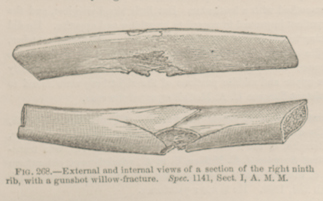Title: T——, William
Source text: Surgeon General Joseph K. Barnes, United States Army, The Medical and Surgical History of the War of the Rebellion. (1861–65.), Part 1, Volume 2 (Washington, D.C.: Government Printing Office, 1870), 567-568.
Civil War Washington ID: med.d1e20089
TEI/XML: med.d1e20089.xml
CASE.—Private William T——, Co. C, 33d North Carolina Regiment, aged 21 years, was wounded at Fredericksburg, Virginia, May 3d, 1863, by a conoidal ball, which entered the right side at the eighth intercostal space. He lay on the field during the night in a rain storm and on the next day was conveyed to the field hospital, where he was treated until the 8th, when he was transferred to Lincoln Hospital, Washington. When admitted, his breathing was very laborious; pulse rapid, quick, and non-compressible; expression of the face anxious; sputa frothy and firmly adherent to the cup; breathing carried on principally by the left lung. He said the saliva had been tinged with blood. Sedatives and expectorants were administered. May 19th: Patient suffers from cough, causing intense pain in side. He continued to fail, and died May 21st, 1863. At the necropsy the right lung was found to be compressed, collapsed, and pushed forward; parenchyma pale red; small bronchial tube prominent. The posterior surface was covered with a thick layer of recent yellowish lymph; the anterior surface was of a pale greyish blue color and free from lymph. As viewed in situ the lung extended from the first to the sixth rib, projecting anteriorly nearly to the median line. The portion not visible was firmly bound to the ribs and anterior portion of the diaphragm by adhesions. The lung was separated from the costal pleura by a large quantity of purulent matter measuring twenty-four ounces. The diaphragmatic and costal surfaces were covered with a thick layer of lymph similar to that observed in the lung. The ball had entered the body on the right side, in the eighth intercostal space, passed slightly downward and inward, fracturing the ninth rib a little anteriorly to its angle, passed through the diaphragm and upper posterior part of the right lobe of the liver, reëntered the pleural cavity, having made a wide ragged track, and was found lying on the diaphragm. The track of the ball was lined with lymph. The missile would appear to have struck the rib sidewise, and being much flattened (FIG. 269), after partially fracturing the rib to have been deflected into the ninth intercostal space. The peculiar fracture of the rib is shown in the wood-cut (FIG. 268). The bone and missile are mounted together in the Museum specimen, which was contributed, with notes of the case, by Assistant Surgeon Harrison Allen, U. S. A.

